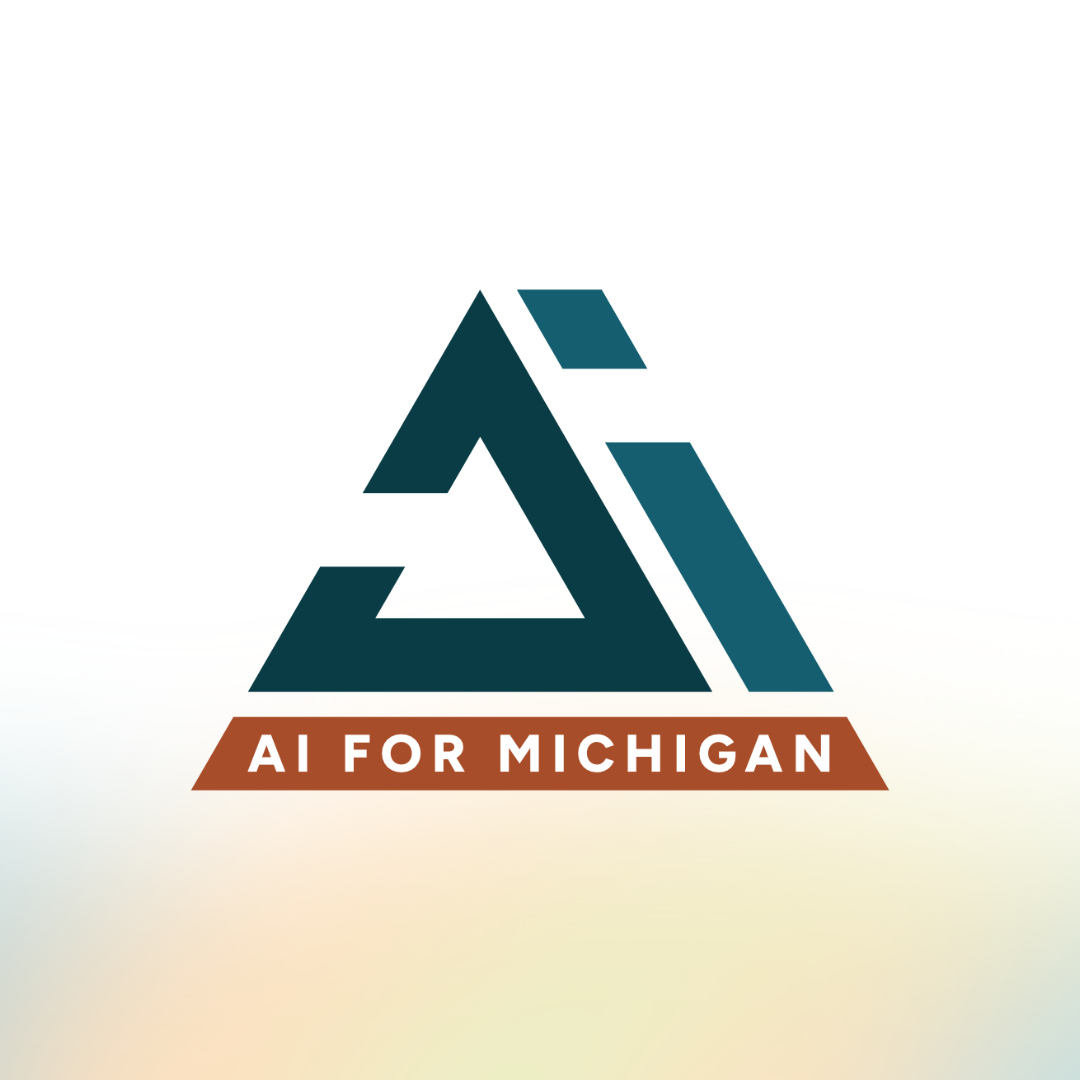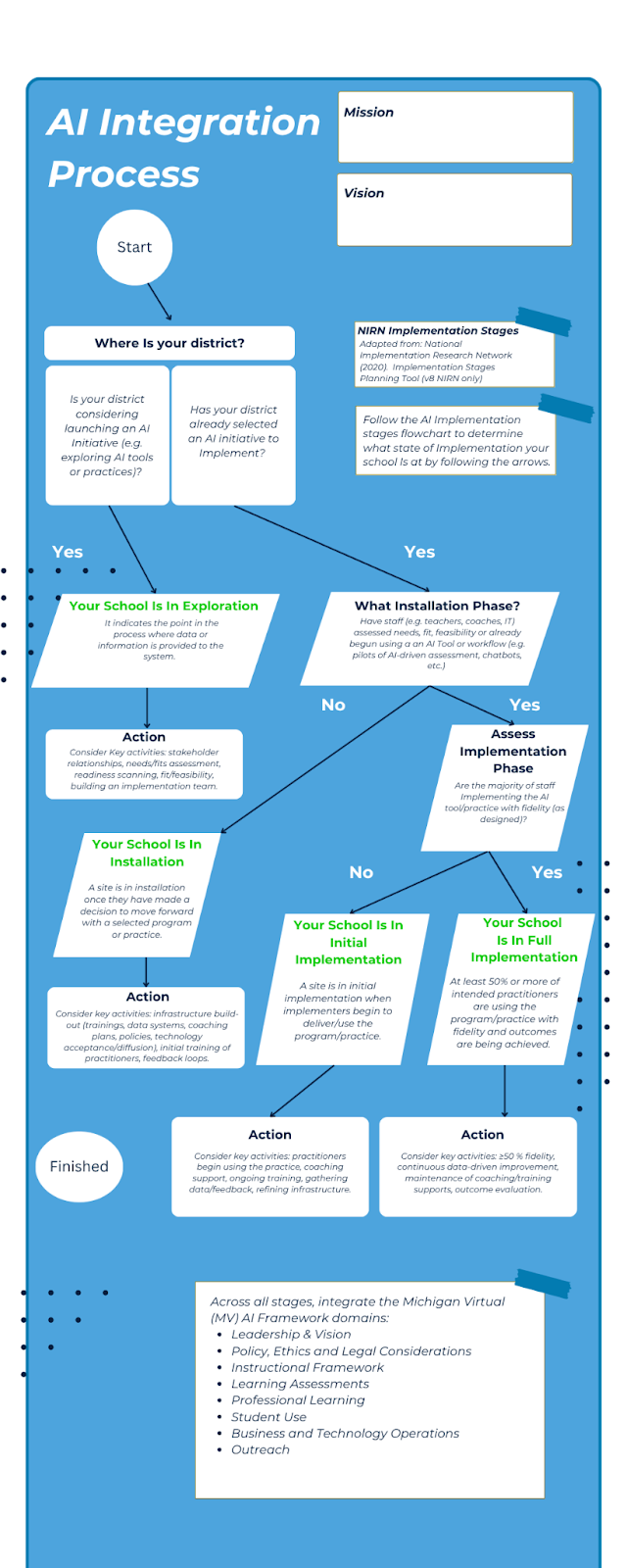AI Integration Development & Implementation Process
This resource provides a roadmap for integrating AI across a K-12 district—aligned with the Michigan Virtual AI Framework. It helps leaders translate mission and beliefs, define an “AI-Ready Graduate,” form a cross-functional team, and move from Exploration to Full Implementation. The template clarifies roles, artifacts, timelines, and fidelity thresholds; embeds policy/ethics, PD, infrastructure, instructional alignment, and transparent communications; and emphasizes continuous improvement, equity, privacy, and measurable student outcomes.



Interested audiences include school boards and superintendents, central office leaders, building administrators, instructional technology directors, data and privacy officers, curriculum leads, teacher leaders, union representatives, communications and family engagement teams, as well as students and guardian/community advisory groups.
This framework serves as an accessible overview of the AI4MI Leadership Scope and Implementation Rubric, providing district leaders with a simplified version of the full resource. The complete rubric and supporting templates can be found by visiting the link at the top of this resource.
🎯 Purpose & Overview
This framework provides a clear roadmap for integrating Artificial Intelligence (AI) across a K–12 district. It aligns with the Michigan Virtual AI Framework and helps leaders move from exploration to full implementation while maintaining ethical, equitable, and transparent practices.
The guide supports districts in:
- Translating mission and beliefs into actionable AI practices
- Defining an AI-Ready Graduate
- Forming a cross-functional leadership team
- Embedding policy, ethics, infrastructure, instructional alignment, and communication
- Measuring fidelity, sustainability, and student outcomes
Intended Audience:
School boards and superintendents, central office leaders, building administrators, instructional technology directors, data and privacy officers, curriculum leads, teacher leaders, union representatives, communications and family engagement teams, as well as students and guardian/community advisory groups.
🧭 [District Name] Mission Statement (AI Addendum)
Example (Insert your district’s mission here):
“[District Name] is dedicated to engaging students and adults in achieving their maximum potential through focused, high-quality programs.”
AI Extension:
We commit to integrating Artificial Intelligence responsibly into teaching, learning, and operations — preparing students and staff to be ethically informed, data-literate, and innovative contributors in an AI-driven world.
💡 Belief Statements (AI-Specific)
Community members of [District] believe that:
- “Putting Kids First” includes protecting student data privacy and ensuring AI serves learners — not replaces teachers.
- High student achievement now includes AI-augmented skills, such as critical evaluation of AI outputs.
- A safe school environment includes safeguards against AI bias and security risks.
- A high-performing staff uses AI tools ethically and effectively.
- Effective communication requires transparency about how AI is used and what data it collects.
- Fiscal responsibility means evaluating AI investments for both short- and long-term impact.
🎓 Profile of an AI-Ready Graduate
When students graduate from [District], they will:
- Demonstrate ethical AI literacy — understanding AI’s strengths, limitations, and biases.
- Use AI-powered tools to collaborate, problem-solve, and innovate.
- Exhibit data privacy awareness and model responsible digital citizenship.
- Communicate confidently about AI-driven learning and adaptation.
🧩 How to Use This Template
- Customize Mission & Beliefs – Replace placeholders and align with district goals.
- Form an AI Team – 8–12 members representing all stakeholder groups.
- Conduct Stage 1 (Exploration) – Needs assessments, feasibility analysis, and buy-in.
- Proceed to Stage 2 (Installation) – Pilot approved tools; set up infrastructure.
- Implement, Monitor, & Adjust (Stages 3–4) – Collect data, improve fidelity, communicate outcomes.
- Plan for Sustainability (Stage 5) – Begin planning before Year 3 for renewal and scaling.
- Document & Communicate – Publish brief “AI Implementation Highlights” for transparency.

⚙️ AI Integration: NIRN Stages Overview
Aligned with the National Implementation Research Network (NIRN) and Michigan Virtual AI Framework domains:
- Governance & Vision
- Policy & Ethics
- Infrastructure
- Capacity Building
- Instructional Framework
- Outreach & Engagement
🔍 Stage 1 – Exploration
Purpose: Assess district readiness, determine fit, and ensure AI aligns with goals and community values.
Key Actions:
- Form an AI Exploration Committee.
- Conduct needs and capacity assessments.
- Use the Hexagon Tool for feasibility.
- Research best practices and case studies.
- Identify potential pilots.
- Review equity and data privacy impacts.
- Obtain stakeholder buy-in.
Outcomes:
- Committee established
- Needs/fit analysis completed
- Vendor short list developed
- Initial board and community support secured
🧱 Stage 2 – Installation
Purpose: Build infrastructure and professional capacity to support pilot implementation.
Key Actions:
- Finalize infrastructure and data governance.
- Convene the AI Steering Committee.
- Develop an AI Policy & Ethics Toolkit.
- Create professional learning plans.
- Present AI Plan & Budget for approval.
- Launch pilot training and communication channels.
Outcomes:
- AI infrastructure deployed
- Policy and ethics framework adopted
- Training programs launched
- Communication and feedback systems in place
🚀 Stage 3 – Initial Implementation
Purpose: Begin classroom use of AI tools and collect early data for improvement.
Key Actions:
- Pilot AI-augmented lessons.
- Continue coaching and training.
- Monitor technical performance.
- Gather stakeholder feedback.
- Refine systems and practices.
Outcomes:
- Teachers using AI tools with fidelity
- Data-driven refinements made
- Coaching networks active
- Family engagement through progress sharing
🌐 Stage 4 – Full Implementation
Purpose: Institutionalize AI practices district-wide and ensure measurable student impact.
Key Actions:
- Monitor fidelity across all buildings.
- Sustain infrastructure and compliance.
- Continue professional development.
- Conduct equity audits and data reviews.
- Publish annual AI Impact Reports.
Outcomes:
- ≥75% classrooms using AI effectively
- Improved student outcomes
- Continuous improvement and transparency
- AI embedded into all district systems
🧑💼 Roles & Responsibilities (AI Context)
Board of Education
The Board approves the district’s AI vision and policy frameworks, allocates funding for AI infrastructure, and ensures community voices are represented in decision-making. They review impact reports on student outcomes and equity data, and adopt policies that safeguard student data and promote ethical AI use.
Central Administration
Central administration champions AI integration as part of the district’s strategic plan. They oversee budgeting, vendor contracts, and communication across departments. Administrators also facilitate AI leadership meetings, track implementation progress, and report AI-related performance indicators such as adoption rates and system uptime.
Technology Director
The Technology Director leads integration of AI tools into curriculum maps and ensures alignment with state standards and Michigan Virtual AI domains. They coordinate pilot programs, maintain “living” AI alignment documentation, and monitor technical performance and instructional outcomes.
Building Administrators
Building leaders ensure AI policies are followed at the school level. They identify teacher participants for pilots, provide time and support for AI training and coaching, and communicate updates to staff and families. Administrators also use AI dashboards to track adoption and address implementation challenges.
Instructional Coaches / AI Coaches
AI Coaches serve as the first line of support for teachers using AI tools. They provide just-in-time classroom coaching, co-teach lessons, troubleshoot issues, and collect feedback from educators. Coaches help design AI lesson templates, co-facilitate professional development, and monitor fidelity of implementation using rubrics or checklists.
Teachers
Teachers engage in professional learning on AI and integrate AI tools into lessons using provided templates and guidelines. They collect and share student data for continuous improvement, collaborate with peers to co-create AI resources, and communicate successes and challenges through established feedback channels.
Students and Parents
Students participate in AI-powered learning experiences such as writing assistants or adaptive practice tools. Parents attend district AI town halls, review communications, and provide feedback on AI’s impact on learning, equity, and engagement. Together, they contribute to transparency and community trust through ongoing dialogue and participation in student showcases or projects.
